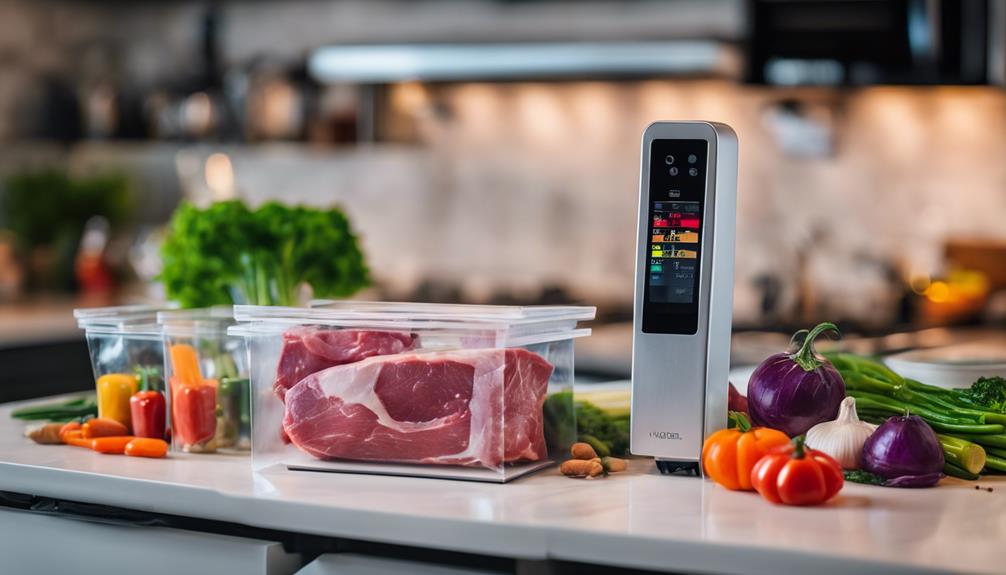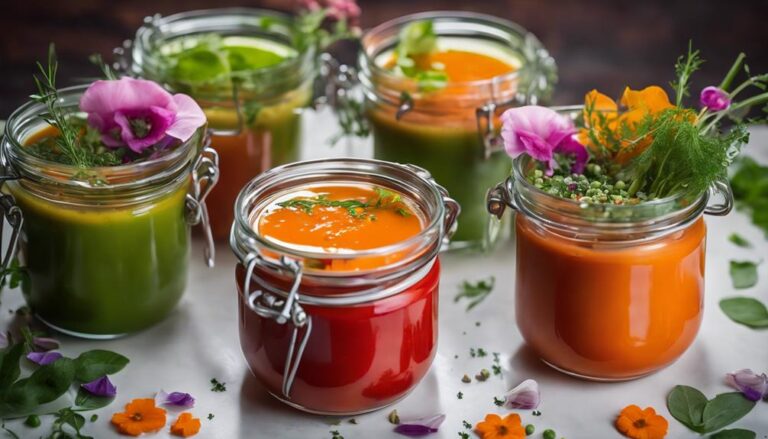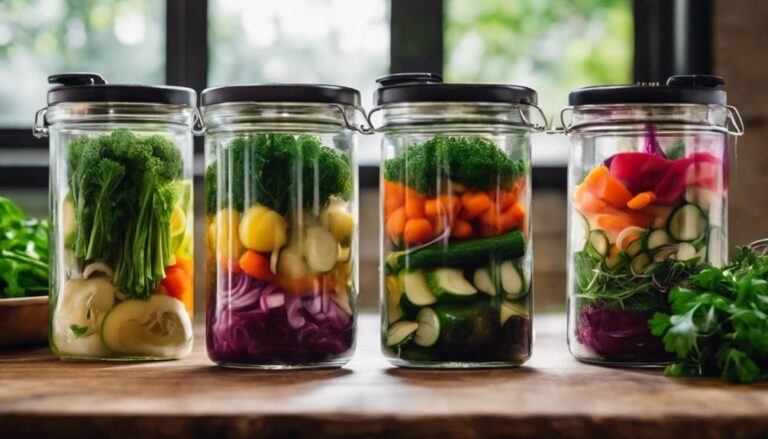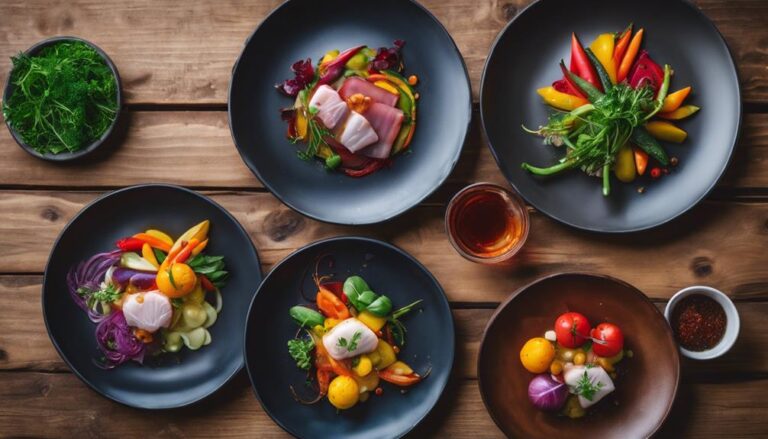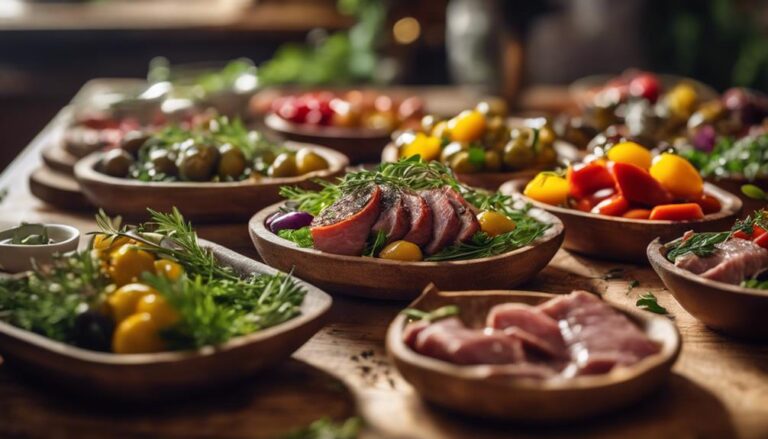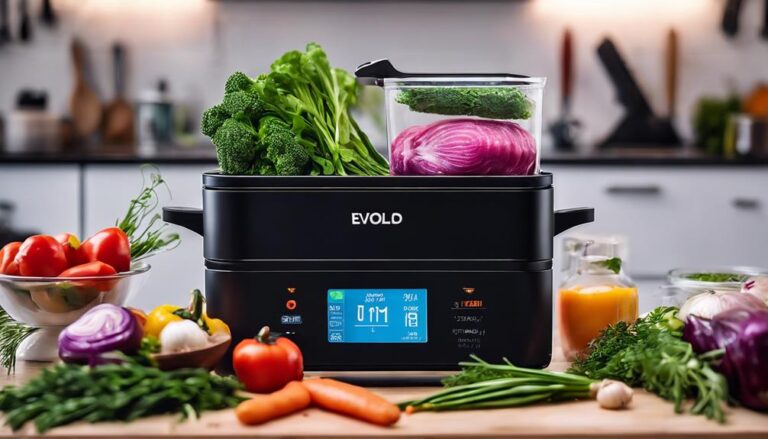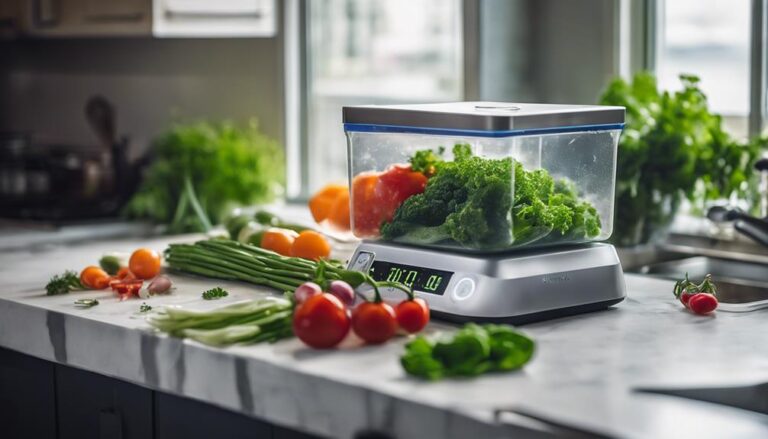Sous Vide Cooking and Its Impact on Macronutrients
Sous vide cooking greatly impacts macronutrients by preserving more proteins and lipids compared to traditional methods. Cooking at controlled low temperatures retains over 90% of these macronutrients. This method also helps maintain essential vitamins and minerals, enhancing their bioavailability. You'll find that sous vide improves the digestibility of proteins, making it easier for your body to absorb nutrients. Additionally, it minimizes nutrient loss and harmful compounds that can form during high-temperature cooking. Overall, sous vide promotes healthier meals with better nutrient retention and flavor. Discovering more about its advantages could further enhance your culinary skills.
What You Will Learn Here
- Sous vide cooking preserves over 90% of proteins and lipids, enhancing macronutrient retention compared to traditional methods.
- The vacuum-sealing process minimizes nutrient leaching, ensuring that macronutrients remain intact during cooking.
- Controlled low temperatures improve protein digestibility, making nutrients easier for the body to absorb.
- Sous vide reduces harmful compound formation, promoting healthier macronutrient profiles in cooked foods.
Nutritional Importance of Meat
Meat plays an important role in your diet, providing essential protein and nutrients that support overall health and bodily functions.
It's a notable source of essential nutrients, including B vitamins, zinc, selenium, and heme-iron. The nutritional value of meat is impressive, with a high nutrient density that often surpasses that of non-meat protein sources. This makes it a valuable addition to meals, especially for those looking to serve others nutritious dishes.
Cooking methods, such as heat treatment, are necessary for ensuring safety and enhancing the sensory quality of meat. Techniques like sous vide cooking not only improve the bioaccessibility of minerals but also help preserve the nutritional properties of the meat. Proper cooking methods can make essential nutrients more available for absorption, which is vital for maintaining good health.
However, it's important to remember that while red meat has both risks and benefits, the way you prepare it can greatly influence its health implications. By choosing appropriate cooking methods, you can create delicious meals that maximize the nutritional benefits of meat, ensuring that everyone enjoys its rich flavors and essential nutrients.
Overview of Sous Vide Cooking
One innovative cooking method that's gaining popularity for preparing meat is sous vide, which involves vacuum-sealing food and cooking it at precise temperatures for extended periods. This technique offers numerous benefits, particularly regarding nutritional value and food safety. By maintaining a controlled temperature, sous vide cooking enhances moisture preservation and results in tender meat that retains its flavor.
Here's a quick comparison of sous vide cooking with traditional methods:
| Aspect | Sous Vide Cooking | Traditional Cooking |
|---|---|---|
| Temperature Control | Precise, low-temperature cooking | High, variable temperatures |
| Nutritional Value | Higher retention of vitamins/minerals | Often reduced due to heat |
| Food Safety | Lower microbial contamination risk | Higher risk from improper cooking |
Using sous vide, you can considerably reduce cooking losses, enhancing the bioaccessibility of essential minerals like zinc and iron. Plus, by avoiding high temperatures, you minimize harmful compound formation. Ultimately, this method not only enhances the sensory qualities of food but also elevates your dining experience, allowing you to serve others with confidence in both taste and safety.
Macronutrient Preservation Techniques
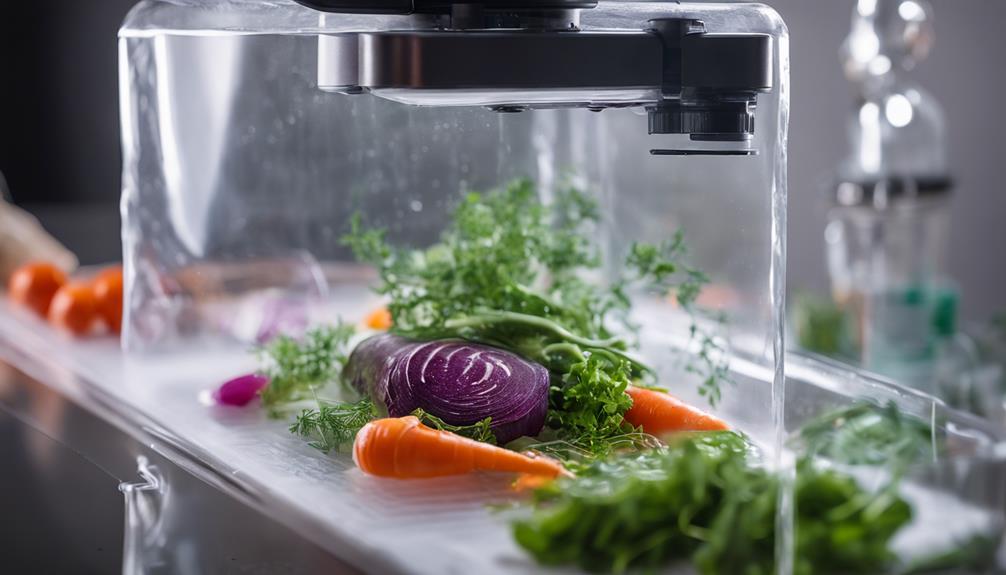
Using sous vide cooking techniques, you can effectively preserve macronutrients, ensuring that proteins, fats, and carbohydrates remain intact and bioavailable. This method employs low-temperature, long-time cooking, which helps retain over 90% of proteins and lipids compared to traditional high-heat methods. By sealing food in vacuum-sealed bags, you prevent nutrients from leaching into cooking water, maintaining the integrity of macronutrients throughout the process.
Moreover, sous vide cooking enhances protein digestibility, making these essential macronutrients more accessible for absorption. This is especially beneficial for those with digestive concerns, as it allows for easier consumption of high-quality protein. Cooking at controlled temperatures, typically between 60°C and 90°C, also reduces the formation of harmful compounds that can arise from high-temperature cooking, further preserving the nutritional profile of your meals.
Additionally, this technique allows for the preparation of larger quantities of food without compromising nutrient retention. As you serve others, you can confidently provide meals that not only taste great but also support their health by maintaining crucial macronutrients. Embracing sous vide cooking can elevate your food preparation efforts while ensuring nutritional benefits.
Effects on Vitamins and Minerals
Sous vide cooking greatly boosts the retention of vitamins and minerals, ensuring you get the most nutritional value from your meals. This method preserves thermolabile vitamins like vitamin C and B vitamins far better than conventional cooking techniques, like boiling, which can lead to significant nutrient loss.
By using sous vide, you enhance the bioaccessibility of essential minerals in your food, making them easier for your body to absorb.
Here are some incredible benefits of this cooking method:
- You can retain up to 862 mg more zinc.
- Enjoy an additional 314 mg of iron in your meals.
- Experience a boost of 109 mg in potassium.
- Benefit from improved digestibility of proteins and amino acids.
Sous vide cooking not only helps maintain the nutritional profile of the food but also increases soluble protein and free amino acids. This results in meals that aren't only flavorful but also nutritious.
Impact on Meat Quality
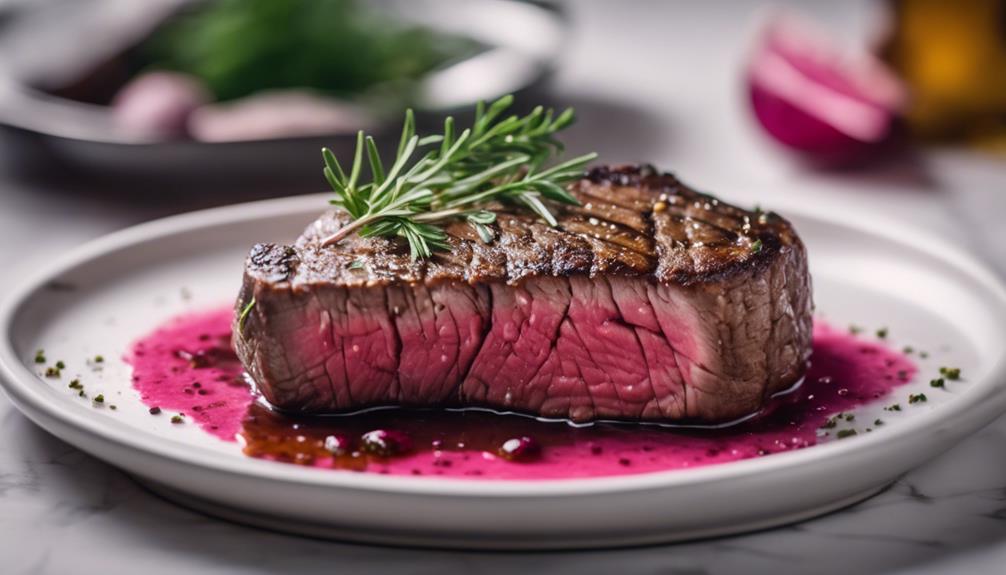
Cooking meat with the sous vide method locks in moisture and enhances tenderness, resulting in a juicier and more flavorful final product. When you use controlled low temperatures, typically between 50°C to 90°C, you not only retain moisture but also improve meat quality considerably. This method minimizes the formation of harmful compounds often produced during traditional cooking methods.
One of the standout benefits of sous vide cooking is its ability to enhance the sensory qualities of meat. You'll notice richer aromas and flavors, thanks to the preservation of natural juices. Additionally, sous vide techniques improve nutrient digestibility, making important nutrients like proteins and amino acids more accessible.
Moreover, sous vide cooking increases the bioaccessibility of essential minerals, such as iron and zinc. Unlike traditional boiling methods, which may diminish these nutrients, sous vide guarantees they remain available for absorption.
Health Implications of Sous Vide
How does sous vide impact your health? Sous vide cooking not only elevates the flavor of your meals but also enhances their nutritional quality. By using controlled low temperatures, this technique preserves essential vitamins and minerals, improving nutrient absorption. Here are a few health implications to reflect on:
- Increased mineral content: You can enjoy significant boosts in nutrients like zinc and iron, which are crucial for your body's functions.
- Reduced harmful compounds: Sous vide cooking minimizes the formation of harmful substances often created during high-temperature cooking methods.
- Improved digestibility: The gentle cooking process breaks down collagen in meats, making them easier to digest and aiding in nutrient absorption.
- Higher bioavailability: Nutrients remain sealed within the food, ensuring you get the maximum benefit from every meal.
With sous vide cooking, you're not just preparing food; you're serving others a healthier, more nourishing option. This method enhances the health benefits of your meals, allowing you to prioritize the well-being of your loved ones while enjoying delicious, flavorful dishes.
Your health and theirs will appreciate the thoughtful approach of sous vide.
Comparative Cooking Methods
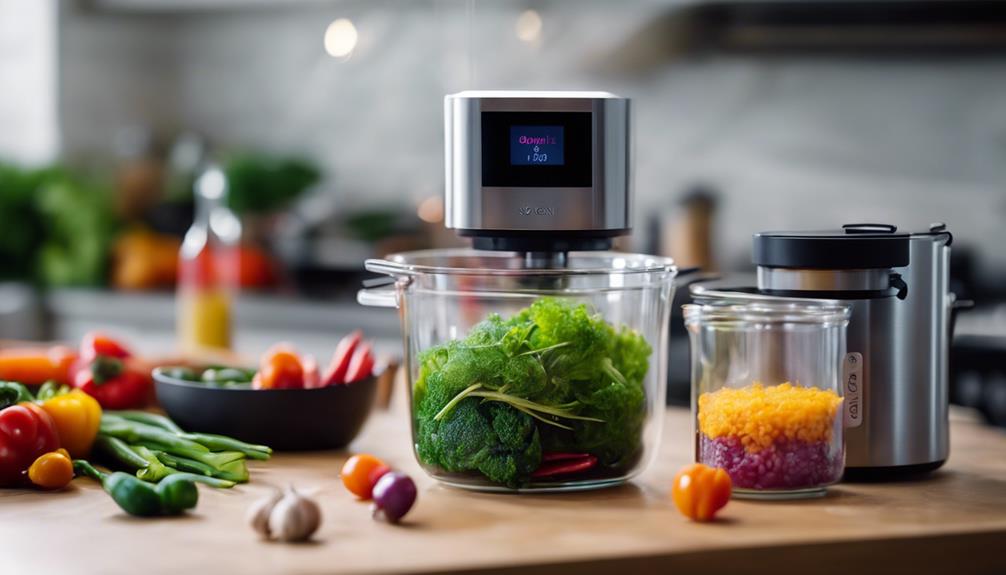
Comparing sous vide to traditional cooking methods reveals significant differences in nutrient retention and flavor preservation. Sous vide cooking uses precise temperature control, typically between 50°C and 90°C, allowing you to cook food for extended periods without losing essential nutrients. In contrast, traditional cooking methods, especially boiling, often lead to a 20% to 40% loss of thermolabile vitamins like B vitamins. This means that when you're preparing meals, sous vide can help maintain the quality of the food you serve.
Additionally, studies show that sous vide improves the bioaccessibility of crucial minerals such as zinc, iron, and copper. Traditional boiling, on the other hand, may reduce the availability of these nutrients. With sous vide, you also experience lower cooking losses, which means more of the valuable macronutrients remain intact.
Moreover, this cooking method preserves the sensory qualities of meats and vegetables, enhancing their natural flavors and textures. By choosing sous vide cooking, you're not only providing nutritious meals but also offering dishes that are more flavorful and digestible, making it an excellent choice for serving family and friends.
Future Research Directions
Future research should prioritize optimizing sous vide parameters to enhance nutrient retention and improve the bioaccessibility of macronutrients in various foods. This pursuit can greatly benefit those looking to serve nutritious meals. Here are some key areas to explore:
- Temperature and Time Optimization: Fine-tuning sous vide cooking conditions can maximize the retention of essential nutrients.
- Digestibility of Plant-Based Proteins: Investigating how sous vide cooking affects the digestibility of plant-based proteins compared to traditional methods could support vegetarian and vegan diets.
- Thermolabile Vitamins Stability: Researching the impact of sous vide on thermolabile vitamins is vital for ensuring food safety and maintaining nutritional quality.
- Consumer Perceptions: Understanding how consumers perceive the nutritional benefits of sous vide can encourage its adoption in home kitchens and food services.
Frequently Asked Questions
Does Sous Vide Affect Nutrients?
Sous vide cooking enhances nutrient retention, flavor, and texture by using precise temperature control and extended cooking times. It preserves vitamins, minimizes mineral loss, and guarantees food safety while retaining moisture, perfect for serving others.
Is Cooking Sous Vide Healthier?
Yes, cooking sous vide offers numerous benefits. You'll enjoy nutrition preservation, enhanced flavors, improved texture, and precise cooking. It promotes food safety, supports portion control, and aligns with health trends, making meal prep a breeze for serving others.
What Are the Disadvantages of Sous Vide Cooking?
When considering sous vide cooking, you'll face equipment costs, long cooking times, and potential food safety issues. While it improves texture, you might miss out on flavor enhancement and traditional culinary techniques for meal prep and portion control.
What Are the Side Effects of Sous Vide Cooking?
When you explore sous vide cooking, be aware of sous vide safety concerns like plastic leaching and temperature control issues. Improper techniques can affect food preservation, texture enhancement, and flavor infusion, impacting your meal prep experience.
Conclusion
To summarize, sous vide cooking offers a unique approach to preparing meat that helps preserve macronutrients and enhances overall quality.
By using precise temperature control, this method minimizes nutrient loss while maintaining flavor and tenderness.
Compared to traditional cooking techniques, sous vide can be a healthier option, though it's important to take food safety into account.
Continued research will further illuminate the benefits and potential drawbacks, helping you make informed choices about your cooking methods and dietary habits.
